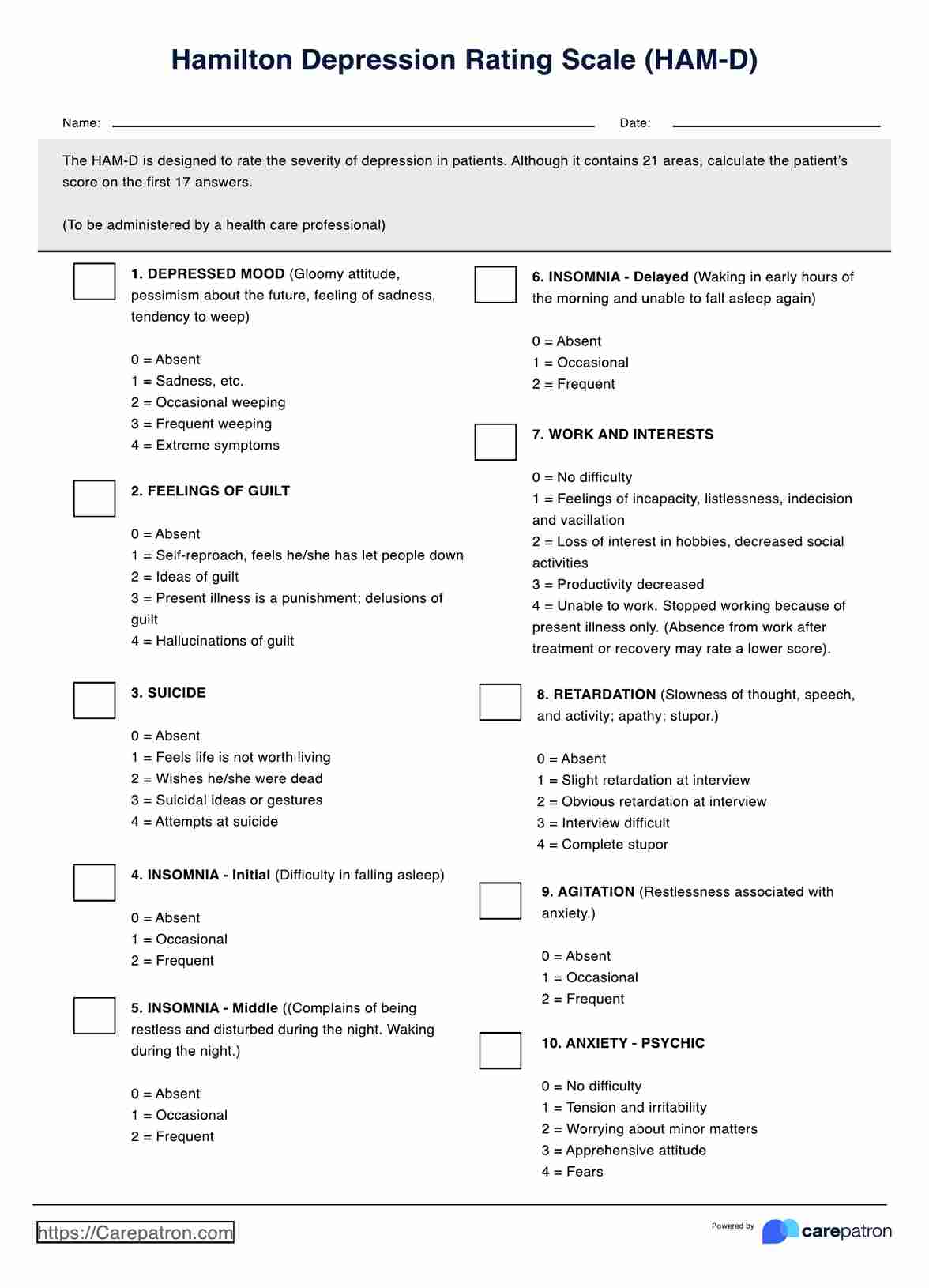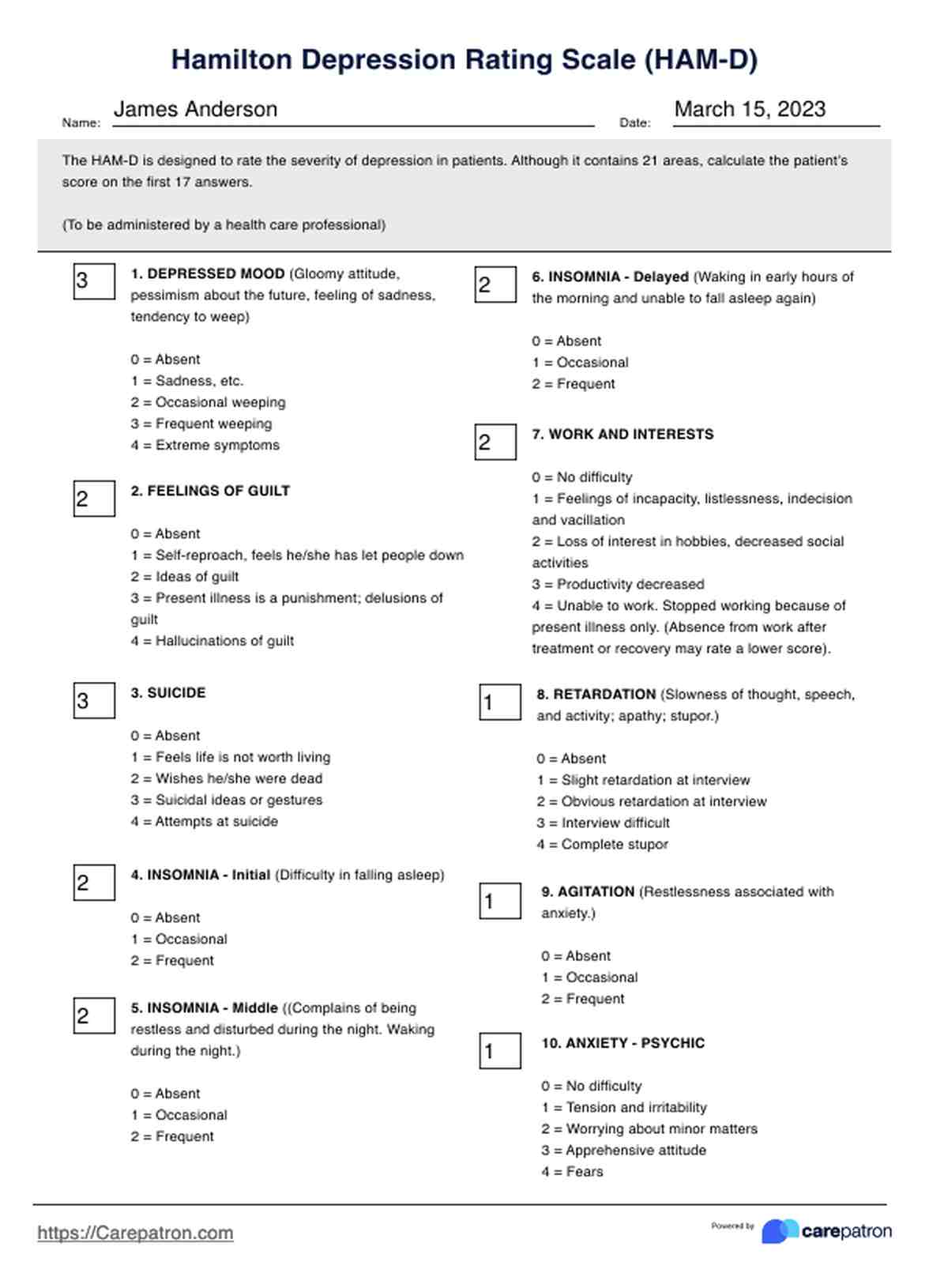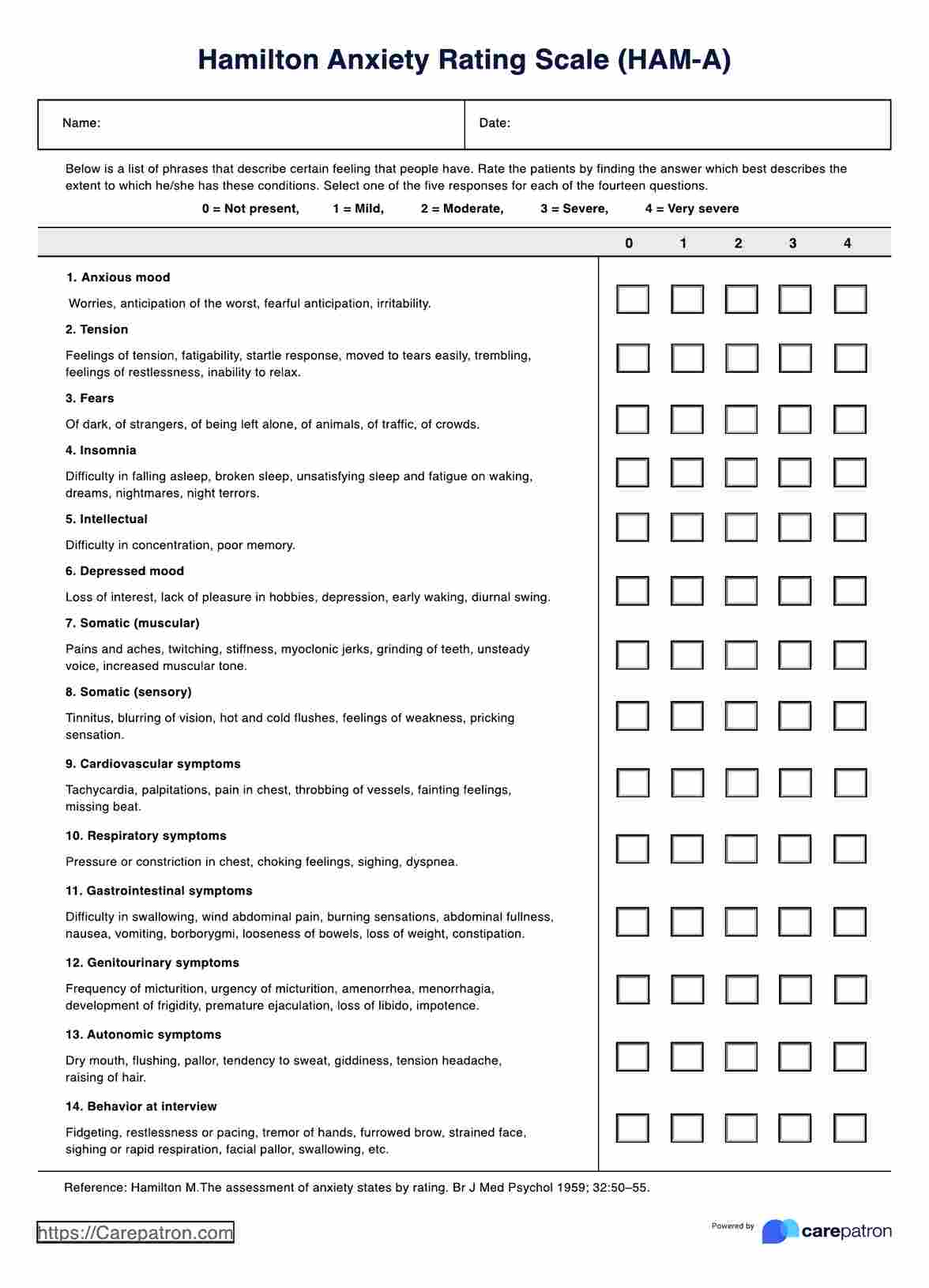Hamilton Depression Scale
Hamilton Depression Scale is a clinical tool that assesses the severity of a depressive disorder. Download this PDF to better measure patients’ depression.


What is the Hamilton Depression Scale test?
The Hamilton Depression Rating Scale (HAM-D), also known as the Hamilton Rating Scale for Depression, is a widely used tool in clinical practice to assess the severity of depressive symptoms. Developed by Max Hamilton in the late 1950s, it remains a cornerstone in evaluating depression's impact on individuals.
This rating scale consists of 21 items designed to capture various aspects of depression, such as mood, guilt, suicidal thoughts, insomnia, and anxiety. Each item is scored on a scale from 0 to 4 or 0 to 2, depending on the severity of the symptom, with higher scores indicating more severe depressive symptoms. The total score provides an overall measure of depression severity, guiding clinicians in diagnosis and treatment planning.
The HAM-D is particularly valuable in diagnosing major depressive disorder (MDD), a common mental health condition characterized by persistent and profound feelings of sadness, worthlessness, and loss of interest or pleasure in activities. By systematically evaluating symptoms across multiple domains, the scale helps differentiate between mild, moderate, and severe depression, informing appropriate interventions.
In clinical settings, the HAM-D is often administered by trained healthcare professionals, including psychiatrists, psychologists, and primary care physicians. It complements other assessment tools, such as the Beck Depression Inventory and the Brief Depression Severity Measure, enhancing the accuracy of diagnosis and monitoring treatment progress.
Importantly, the HAM-D aligns with the diagnostic criteria outlined in the Diagnostic and Statistical Manual of Mental Disorders (DSM), providing a standardized approach to assessing depressive disorders. Its widespread use in research and clinical trials further validates its reliability and validity as a measure of depressive symptomatology.
Despite its strengths, the HAM-D is not without limitations. Some critics argue that it may not adequately capture certain aspects of depression, such as atypical symptoms or fluctuations in mood over time. Additionally, interpretation of scores requires clinical judgment and consideration of individual differences in symptom presentation.
The Hamilton Depression Rating Scale remains an indispensable tool in the assessment and management of depression, offering clinicians valuable insights into the nature and severity of depressive symptoms and guiding personalized treatment strategies.
Hamilton Depression Scale Template
Hamilton Depression Scale Example
How to use this Hamilton Depression Scale?
Step 1: Familiarize yourself with the scale
Before administering the Hamilton Depression Scale (HAM-D), familiarize yourself with its items, scoring system, and interpretation guidelines. Understanding the scale's purpose and structure is crucial for accurate assessment.
Step 2: Prepare the patient
Explain the purpose of the assessment to the patient, ensuring they understand that it aims to evaluate depressive symptoms such as depressed mood, somatic symptoms, and cognitive impairments. Assure confidentiality to encourage honest responses.
Step 3: Conduct a structured interview
Conduct a structured interview using the HAM-D, systematically asking the patient about various aspects of depressive symptomatology. Use open-ended questions to encourage detailed responses, ensuring comprehensive assessment.
Step 4: Rate each item
For each item on the scale, assess the severity of the symptom-based on the patient's responses. Use the provided rating scale (0 to 4) to quantify the severity, considering the extent of impairment caused by each symptom.
Step 5: Sum the Scores
After rating each item, sum the scores to obtain the total score for the patient. This score reflects the overall severity of depressive symptoms, ranging from minimal to severe depression.
Step 6: Interpret the results
Interpret the total score based on established guidelines. Scores below a certain threshold suggest minimal or mild depression, while higher scores indicate moderate to severe depression. Consider the patient's context, including age, gender, and medical history, when interpreting results.
Step 7: Document Findings
Document the patient's responses and total score accurately in their medical records. Include relevant details such as the assessment date, any contextual factors affecting the evaluation, and the clinician's observations during the interview.
Step 8: Follow-up and monitoring
Use the HAM-D as part of ongoing assessment and monitoring of depressive symptoms. Re-administer the scale periodically to track changes in symptom severity and evaluate treatment efficacy.
Step 9: Consider additional assessments
Consider supplementary assessments or diagnostic tools to complement the HAM-D findings in certain cases. This may include self-report measures like the Patient Health Questionnaire or structured interviews for specific disorders such as generalized anxiety disorder.
Step 10: Ensure reliability and validity
Adhere to standardized administration procedures to ensure the reliability and validity of HAM-D scores. Consider factors such as inter-rater reliability and psychometric properties when using the scale in clinical practice or research settings.
The Hamilton Depression Scale is a valuable tool for assessing major depressive disorder and depression severity. By following these steps, healthcare professionals can effectively measure depression and tailor treatment plans to address the patient's needs.
When would you typically use this Hamilton Depression Scale assessment?
The Hamilton Depression Scale assessment is typically used in various clinical settings to evaluate depression severity and guide treatment decisions for individuals experiencing depressive symptoms.
In clinical practice
Healthcare professionals, including clinical psychologists and psychiatrists, often utilize the Hamilton Depression Scale during clinical interviews with patients presenting depressive symptomatology. It serves as a structured assessment tool to systematically evaluate symptoms such as depressed mood, weight loss, insomnia, and somatic complaints. This aids in diagnosing major depressive disorder (MDD) and assessing the severity of depression, particularly in cases of moderate depression where clinical judgment alone may be insufficient.
In research and clinical trials
Researchers and clinicians also employ the Hamilton Depression Scale in research settings, including clinical trials and systematic reviews. It measures depression scores before and after interventions, helping to assess treatment efficacy and compare outcomes across different interventions. Its inclusion criteria in studies often require validated measures like the Hamilton Depression Scale to ensure consistency and reliability of results.
Comparative studies
Comparative studies, such as meta-analyses and critical reviews, frequently incorporate the Hamilton Depression Scale to evaluate the effectiveness of different interventions for depression. By analyzing data from various sources, researchers can determine the scale's reliability, validity, and sensitivity to change over time.
Specialized populations
The Hamilton Depression Scale is also valuable in assessing depression in specific populations, such as depressed inpatients, individuals with bipolar disorder, or those with co-occurring mental illnesses. Its structured nature allows for consistent assessment across diverse patient groups, enhancing diagnostic accuracy and treatment planning.
Validation and standardization
The Hamilton Depression Scale has been extensively validated and standardized, making it a gold standard in depression assessment. Its psychometric properties, including test-retest and inter-rater reliability, have been well-established through scientific literature and clinical studies. Additionally, the availability of self-report versions, such as the Inventory of Depressive Symptomatology and the Patient Health Questionnaire (PHQ), further enhances its utility in clinical and research settings.
The Hamilton Depression Scale assessment is appropriate for clinical practice, research studies, and comparative analyses to assess depression severity and guide treatment decisions across diverse populations and settings. Its reliability, validity, and systematic approach make it an indispensable tool in clinical psychology and mental health research.
Who can use these printable Hamilton Depression Scales?
The printable Hamilton Depression Scales are versatile tools that can be utilized by a range of practitioners involved in assessing and managing depression. Here are several relevant practitioners who can effectively use this form:
Psychiatrists and psychologists
Psychiatrists and clinical psychologists are key users of the Hamilton Depression Scales. They employ these printable forms to assess depressive symptoms in their patients, aiding in the diagnosis of mental illnesses like major depressive disorder (MDD), bipolar disorder, and other mood disorders. By administering the scale during structured interviews, they can accurately evaluate the severity of depression and monitor changes over time.
Primary care physicians
Primary care physicians play a crucial role in identifying and managing mental health conditions, including depression. Using printable Hamilton Depression Scales, they can assess symptoms in depressed patients during routine check-ups or mental health screenings. This facilitates early detection and intervention, leading to better outcomes for patients with depression.
Clinical researchers
Researchers conducting clinical trials, critical reviews, or studies on depression rely on standardized assessment tools like the Hamilton Depression Scales to measure depression scores. By administering these scales to study participants, researchers can accurately assess the efficacy of interventions, compare treatment outcomes, and contribute valuable insights to the scientific literature on depression.
Mental health professionals in specialized settings
Mental health professionals working in specialized settings, such as psychiatric hospitals, community mental health centers, or outpatient clinics, can benefit from using printable Hamilton Depression Scales. These professionals may include psychiatric nurses, social workers, and counselors, who play a vital role in assessing and treating depressed patients.
Child and adolescent psychiatrists/psychologists
Practitioners specializing in child and adolescent mental health utilize depression assessment instruments tailored to younger populations, such as the Children's Depression Rating Scale (CDRS). Printable versions of these scales allow child and adolescent psychiatrists and psychologists to assess depressive symptoms and provide appropriate interventions for their younger patients.
The printable Hamilton Depression Scales serve as valuable tools for a wide range of practitioners involved in assessing symptoms of depression and managing mental illness. From psychiatrists and psychologists to primary care physicians and clinical researchers, these scales provide a standardized and reliable method for evaluating depression severity and guiding treatment decisions across various clinical and research settings.
Benefits of free Hamilton Depression Rating Scale
Cost-effective assessment
The free availability of the Hamilton Depression Rating Scale (HAM-D) allows healthcare professionals to utilize a widely recognized and validated assessment tool without incurring additional costs. This accessibility promotes the efficient evaluation of depressive symptomatology, especially in resource-constrained healthcare settings.
Standardized measure for severity
As a standardized measure, the HAM-D provides a consistent framework for healthcare professionals to assess and quantify the severity of depressive symptoms. Its structured nature helps ensure uniformity in evaluating various aspects of depression, aiding in the diagnosis and treatment planning process.
Alignment with diagnostic criteria
The HAM-D aligns with the diagnostic criteria outlined in the Diagnostic and Statistical Manual of Mental Disorders (DSM). This alignment enhances its utility for healthcare professionals in diagnosing depressive disorders, including mild depression and facilitating adherence to established diagnostic guidelines.
Versatility across populations:
The free availability of the HAM-D allows healthcare professionals to use this assessment across diverse populations, from adults to adolescents. Its adaptability makes it a valuable tool for evaluating depressive symptomatology across different age groups, contributing to a comprehensive understanding of mental health.
Supports self-report instruments
While the HAM-D is often administered by health care professionals, its availability for free use complements self-report instruments in assessing depressive symptoms. The combination of clinician-administered assessments like the HAM-D and self-report measures enhances the overall evaluation of depression, capturing a more comprehensive picture of the patient's mental health.
Facilitates routine monitoring
The accessibility of the HAM-D enables healthcare professionals to incorporate routine monitoring of depressive symptoms into clinical practice. This regular assessment supports the ongoing evaluation of treatment effectiveness, allowing for timely adjustments and personalized care for individuals experiencing mild depression or other levels of severity.
The free availability of the Hamilton Depression Rating Scale offers healthcare professionals a cost-effective, standardized, and versatile tool for assessing depressive symptoms across diverse populations. Its alignment with diagnostic criteria, support for self-report instruments, and facilitation of routine monitoring contribute to its widespread use in clinical practice.
References
Bagby, R. M., Ryder, A. G., Schuller, D. R., & Marshall, M. B. (2004). The Hamilton Depression Rating Scale: Has the gold standard become a lead weight? The American Journal of Psychiatry, 161(12), 2163–2177.
Williams, J. B., Kobak, K. A., Bech, P., Engelhardt, N., Evans, K., Lipsitz, J. D., Olin, J., & Pearson, J. (2012). The GRID-HAMD: Standardization of the Hamilton Depression Rating Scale. The International Journal of Neuropsychopharmacology, 15(1), 01–14.
Zimmerman, M., Martinez, J. H., Young, D., Chelminski, I., & Dalrymple, K. (2013). Severity classification on the Hamilton Depression Rating Scale. Journal of Affective Disorders, 150(2), 384–388.
Commonly asked questions
A trained healthcare professional typically administers the Hamilton Depression Scale through a structured interview format. Patients are asked a series of questions related to various depressive symptoms, and their responses are scored based on the severity of each symptom.
The Hamilton Depression Scale assesses a wide range of depressive symptoms, including mood disturbances, sleep disturbances, appetite changes, feelings of guilt or worthlessness, and physical symptoms such as fatigue or psychomotor agitation.
Each item on the Hamilton Depression Scale is scored on a scale from 0 to 4, with higher scores indicating more severe depressive symptoms. The total score is calculated by summing the scores for all items, with a higher total score indicating greater severity of depression.


















-template.jpg)


























































































